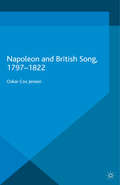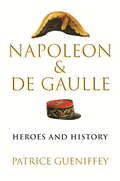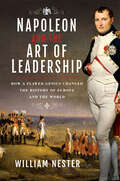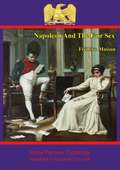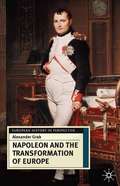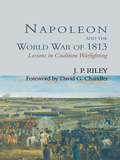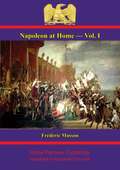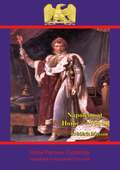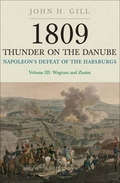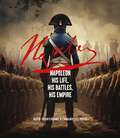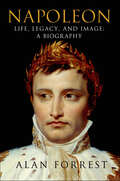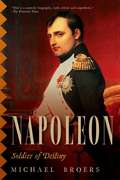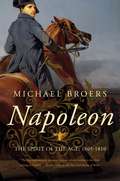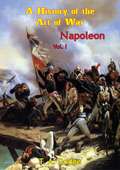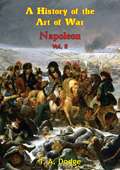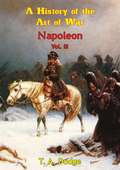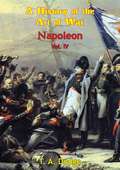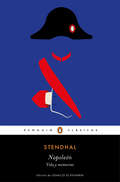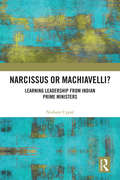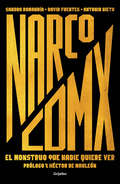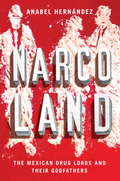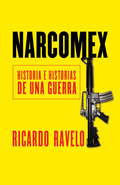- Table View
- List View
Napoleon and British Song, 1797-1822 (War, Culture and Society, 1750 –1850)
by Oskar Cox JensenThis study offers a radical reassessment of a crucial period of political and cultural history. By looking at some 400 songs, many of which are made available to hear, and at their writers, singers, and audiences, it questions both our relationship with song, and ordinary Britons' relationship with Napoleon, the war, and the idea of Britain itself.
Napoleon and de Gaulle: Heroes and History
by Patrice GueniffeyOne of France’s most famous historians compares two exemplars of political and military leadership to make the unfashionable case that individuals, for better and worse, matter in history. Historians have taught us that the past is not just a tale of heroes and wars. The anonymous millions matter and are active agents of change. But in democratizing history, we have lost track of the outsized role that individual will and charisma can play in shaping the world, especially in moments of extreme tumult. Patrice Gueniffey provides a compelling reminder in this powerful dual biography of two transformative leaders, Napoleon Bonaparte and Charles de Gaulle. Both became national figures at times of crisis and war. They were hailed as saviors and were eager to embrace the label. They were also animated by quests for personal and national greatness, by the desire to raise France above itself and lead it on a mission to enlighten the world. Both united an embattled nation, returned it to dignity, and left a permanent political legacy—in Napoleon’s case, a form of administration and a body of civil law; in de Gaulle’s case, new political institutions. Gueniffey compares Napoleon’s and de Gaulle’s journeys to power; their methods; their ideas and writings, notably about war; and their postmortem reputations. He also contrasts their weaknesses: Napoleon’s limitless ambitions and appetite for war and de Gaulle’s capacity for cruelty, manifested most clearly in Algeria. They were men of genuine talent and achievement, with flaws almost as pronounced as their strengths. As many nations, not least France, struggle to find their soul in a rapidly changing world, Gueniffey shows us what a difference an extraordinary leader can make.
Napoleon and the Art of Leadership: How a Flawed Genius Changed the History of Europe and the World
by William NesterThis deep dive into the mind of the complex, controversial political and military leader is “a great addition to the field of Napoleonics” (Journal of Military History).No historical figure has provoked more controversy than Napoleon Bonaparte. Was he an enlightened ruler or brutal tyrant? An insatiable warmonger or a defender of France against the aggression of the other great powers? Kind or cruel, farsighted or blinkered, a sophisticate or a philistine, a builder or a destroyer? Napoleon was at once all that his partisans laud, his enemies condemn, and much more. He remains fascinating, because he so dramatically changed the course of history and had such a complex, paradoxical character.One thing is certain: If the art of leadership is about getting what one wants, then Napoleon was among history’s greatest masters. He understood and asserted the dynamic relationship among military, economic, diplomatic, technological, cultural, psychological—and thus political—power. War was the medium through which he was able to demonstrate his innate skills, leading his armies to victories across Europe. He overthrew France’s corrupt republican government in a coup, then asserted near dictatorial powers. Those powers were then wielded with great dexterity in transforming France from feudalism to modernity with a new law code, canals, roads, ports, schools, factories, national bank, currency, and standard weights and measures. With those successes, he convinced the Senate to proclaim him France’s emperor and even got the pope to preside over his coronation. He reorganized swaths of Europe into new states and placed his brothers and sisters on the thrones.This is Napoleon as has never been seen before. No previous book has explored his seething labyrinth of a mind more deeply and broadly or revealed more of its complex, provocative, and paradoxical dimensions. Napoleon has never before spoken so thoroughly about his life and times through the pages of a book, nor has an author so deftly examined the veracity or mendacity of his words. Within are dimensions of Napoleon that may charm, appall, or perplex, many buried for two centuries and brought to light for the first time. Napoleon and the Art of Leadership is a psychologically penetrating study of the man who had such a profound effect on the world around him that the entire era still bears his name.
Napoleon and the Fair Sex
by Anon. Frédéric MassonFrédéric Masson stands as one of the foremost historians that France has ever produced. His specialist subject was the era of Napoleon, and few men have written such brilliant and penetrating studies of the Emperor. In this volume, translated from his book 'Napoléon et les femmes', Masson charts the Emperor's amorous adventures throughout his life. It is a wonder that Napoleon had any time to engage in the domination of Europe, given his propensity to ladies; he was twice married, cuckolded numerous times, frequent lover of opera singers and actresses, step-father to two children, father to his heir, the Duke of Reichstadt, and the father of at least two illegitimate children. This work masterfully brings Napoleon's often tumultuous relationships with the women in his life with full colour and detail.Author -- Masson, Frédéric, 1847-1923.Translator -- Anon.Text taken, whole and complete, from the edition published in London : W. Heinemann, 1896 Original Page Count - 320 pages.Illustrations -- 10 portraits.
Napoleon and the Transformation of Europe
by Alexander GrabCreating a French Empire and establishing French dominance over Europe constituted Napoleon's most important and consistent aims. In this fascinating book, Alexander Grab explores Napoleon's European policies, as well as the response of the European people to his rule, and demonstrates that Napoleon was as much a part of European history as he was a part of French history. Napoleon and the Transformation of Europe: - examines the formation of Napoleon's Empire, the Emporer's impact throughout Europe, and how the Continent responded to his policies - focuses on the principal developments and events in the ten states that comprised Napoleon's Grand Empire: France itself, Belgium, Germany, the Illyrian Provinces, Italy, the Netherlands, Poland, Portugal, Spain, and Switzerland - analyses Napoleon's exploitation of occupied Europe - discusses the broad reform policies Napoleon launched in Europe, assesses their success, and argues that the French leader was a major reformer and a catalyst of modernity on a European scale
Napoleon and the World War of 1813: Lessons in Coalition Warfighting
by J.P. RileyThis analysis of the world war between Napoleon and the 6th coalition in 1813 covers operations in Europe, Spain and North America. It examines the differences between alliances and coalitions, comparing the long-term international relationships in alliances and the short-term union of coalitions.
Napoleon at Home — Vol. I (Napoleon at Home #1)
by Anon. Frédéric MassonMuch has been written about the life of Napoleon, whose actions dominated the beginning of the Nineteenth century; his campaigns have been charted in great detail as have his political manoeuvres; however, his life during his few quiet hours remained less well known - until the renowned Frédéric Masson cast his expert eye on them.Ranging from the court audiences reminiscent of the Ancien Régime kings such as Louis XIV to simple days at home with his extended family, the author draws out the detail of the household of the Emperor. The rooms and daily routines are juxtaposed with the celebrated events of the Imperial calendar to great effect, the mundane and the grand living side by side. As time passed and Napoleon gained more wealth and power, so the routines changed and the splendour increased. The author goes into every facet without losing the reader's interest. An astounding and intimate portrait of Napoleon, the man and the Emperor.Author -- Masson, Frédéric, 1847-1923.Translator -- James E. Matthew.Text taken, whole and complete, from the edition published in London : H. Grevel and Co. and Philadelphia J. B. Lipincott, 1894 Original Page Count - li and 198 pages.Illustrations -- 12 illustrations.
Napoleon at Home — Vol. II (Napoleon at Home #2)
by Anon. Frédéric MassonMuch has been written about the life of Napoleon, whose actions dominated the beginning of the Nineteenth century; his campaigns have been charted in great detail as have his political manoeuvres; however, his life during his few quiet hours remained less well known - until the renowned Frédéric Masson cast his expert eye on them.Ranging from the court audiences reminiscent of the Ancien Régime kings such as Louis XIV to simple days at home with his extended family, the author draws out the detail of the household of the Emperor. The rooms and daily routines are juxtaposed with the celebrated events of the Imperial calendar to great effect, the mundane and the grand living side by side. As time passed and Napoleon gained more wealth and power, so the routines changed and the splendour increased. The author goes into every facet without losing the reader's interest. An astounding and intimate portrait of Napoleon, the man and the Emperor.Author -- Masson, Frédéric, 1847-1923.Translator -- James E. Matthew.Text taken, whole and complete, from the edition published in London : H. Grevel and Co. and Philadelphia J. B. Lipincott, 1894 Original Page Count - 248 pages.Illustrations -- 12 illustrations.
Napoleon's Defeat of the Habsburgs Volume III: Wagram and Znaim (1809: Thunder on the Danube #3)
by John H. Gill&“A very impressive piece of work, and it is unlikely to be surpassed for many years . . . A very valuable guide to Napoleon&’s last great victory&” (HistoryOfWar.org). With this third volume, John Gill brings to a close his magisterial study of the war between Napoleonic France and Habsburg Austria. The account begins with both armies recuperating on the banks of the Danube. As they rest, important action was taking place elsewhere: Eugene won a crucial victory over Johann on the anniversary of Marengo, Prince Poniatowski&’s Poles outflanked another Austrian archduke along the Vistula, and Marmont drove an Austrian force out of Dalmatia to join Napoleon at Vienna. These campaigns set the stage for the titanic Battle of Wagram. Second only in scale to the slaughter at Leipzig in 1813, Wagram saw more than 320,000 men and 900 guns locked in two days of fury that ended with an Austrian retreat. The defeat, however, was not complete: Napoleon had to force another engagement before Charles would accept a ceasefire. The battle of Znaim, its true importance often not acknowledged, brought an extended armistice that ended with a peace treaty signed in Vienna. Gill uses an impressive array of sources in an engaging narrative covering both the politics of emperors and the privations and hardship common soldiers suffered in battle. Enriched with unique illustrations, forty maps, and extraordinary order-of-battle detail, this work concludes an unrivalled English-language study of Napoleon&’s last victory. &“Sheds new light on well-known stages in the battle . . . he has covered more than just an epochal battle in a magnificent book that will satisfy the most avid enthusiasts of Napoleonic era military history.&” —Foundation Napoleon
Napoleon: A Life
by Adam ZamoyskiThe definitive biography of Napoleon, revealing the true man behind the legend"What a novel my life has been!" Napoleon once said of himself. Born into a poor family, the callow young man was, by twenty-six, an army general. Seduced by an older woman, his marriage transformed him into a galvanizing military commander. The Pope crowned him as Emperor of the French when he was only thirty-five. Within a few years, he became the effective master of Europe, his power unparalleled in modern history. His downfall was no less dramatic.The story of Napoleon has been written many times. In some versions, he is a military genius, in others a war-obsessed tyrant. Here, historian Adam Zamoyski cuts through the mythology and explains Napoleon against the background of the European Enlightenment, and what he was himself seeking to achieve. This most famous of men is also the most hidden of men, and Zamoyski dives deeper than any previous biographer to find him. Beautifully written, Napoleon brilliantly sets the man in his European context.
Napoleon: His Life, His Battles, His Empire
by David Chanteranne Emmanuelle PapotExplore the rise and fall of a legend.Napoleon: His Life, His Battles, His Empire offers an unprecedented insight into the life of a man labelled conqueror, emperor, lover and tyrant. Thoroughly researched by expert authors, it examines Napoleon's story from humble beginnings to leader of a vast empire, including detailed studies of the battles that made him a legend - Marengo, Austerlitz, Jena and Wagram.Illustrated with vivid artworks, photographs and incredible historical documents, including love letters to Josephine and treaties signed by Napoleon himself, this is a comprehensive and compelling account of the man who came from nothing and conquered everything.
Napoleon: His Life, His Battles, His Empire
by David Chanteranne Emmanuelle PapotExplore the rise and fall of a legend.Napoleon: His Life, His Battles, His Empire offers an unprecedented insight into the life of a man labelled conqueror, emperor, lover and tyrant. Thoroughly researched by expert authors, it examines Napoleon's story from humble beginnings to leader of a vast empire, including detailed studies of the battles that made him a legend - Marengo, Austerlitz, Jena and Wagram.Illustrated with vivid artworks, photographs and incredible historical documents, including love letters to Josephine and treaties signed by Napoleon himself, this is a comprehensive and compelling account of the man who came from nothing and conquered everything.
Napoleon: Life, Legacy, and Image: A Biography
by Alan ForrestFrom Alan Forrest, a preeminent British scholar, comes an exceedingly readable account of the man and his legendOn a cold December day in 1840 Parisians turned out in force to watch as the body of Napoleon was solemnly carried on a riverboat from Courbevoie on its final journey to the Invalides. The return of their long-dead emperor's corpse from the island of St. Helena was a moment that Paris had eagerly awaited, though many feared that the memories stirred would serve to further destabilize a country that had struggled for order and direction since he had been sent into exile.In this book Alan Forrest tells the remarkable story of how the son of a Corsican attorney became the most powerful man in Europe, a man whose charisma and legacy endured after his lonely death many thousands of miles from the country whose fate had become so entwined with his own.Along the way, Forrest also cuts away the many layers of myth and counter myth that have grown up around Napoleon, a man who mixed history and legend promiscuously. Drawing on original research and his own distinguished background in French history, Forrest demonstrates that Napoleon was as much a product of his times as their creator.
Napoleon: Soldier of Destiny (Reputations Ser. #18)
by Michael BroersWritten with great energy and authority--and using the newly available personal archives of Napoleon himself--the first volume of a majestic two-part biography of the great French emperor and conqueror. All previous lives of Napoleon have relied more on the memoirs of others than on his own uncensored words. This is the first life of Napoleon, in any language, that makes full use of his newly released personal correspondence compiled by the Napoléon Foundation in Paris. All previous lives of Napoleon have relied more on the memoirs of others than on his own uncensored words. Michael Broers' biography draws on the thoughts of Napoleon himself as his incomparable life unfolded. It reveals a man of intense emotion, but also of iron self-discipline; of acute intelligence and immeasurable energy. Tracing his life from its dangerous Corsican roots, through his rejection of his early identity, and the dangerous military encounters of his early career, it tells the story of the sheer determination, ruthlessness, and careful calculation that won him the precarious mastery of Europe by 1807. After the epic battles of Austerlitz, Jena and Friedland, France was the dominant land power on the continent. Here is the first biography of Napoleon in which this brilliant, violent leader is evoked to give the reader a full, dramatic, and all-encompassing portrait.
Napoleon: The Spirit Of The Age: 1805-1810 (Reputations Ser. #18)
by Michael BroersThe second volume in this dynamic three-part life of Napoleon, covering the tumultuous years of 1805 to 1810—marking the zenith of Napoleon’s power and military might across Europe. The second volume of Michael Broers’ three volume life of Napoleon, covering the tumultuous years 1805 to 1810, a period which marks the zenith of Napoleon’s power and military success. Like volume one, it is based on the new version of Napoleon’s correspondence, made available by the Fondation Napoléon in Paris. It is the story of Napoleon’s conquest of Europe—and that of his magnificent Grande Armée— as they sweep through the length and breadth of Europe. Spirit of the Age opens with Napoleon’s as yet untested army making its way through the Bavarian Alps in the early winter of 1805, to fall upon the unsuspecting Austrians and Russians, and crushing them at Austerlitz. This was only the beginning of series of spectacular victories: over the Prussians in 1806, and then the Russians, which brought the Tsar to defeat in 1807. It follows the army into Spain, in 1808, most ill-considered step in his career as ruler, and then through the most daunting triumph of all, the final defeat of Austria at Wagram, in 1809, the bloodiest battle in European history up to that time. These five years encompass the dramas of Napoleon’s separation from Josephine amid the turmoil of ruling a pan-European empire. These years also saw Napoleon navigate plots against him, his clash with the Pope and excommunication, and his loss of trust in many of those closest to him. It closes with his marriage to Marie-Louise, the daughter of his defeated enemy, the Emperor of Austria. With the greatest "trophy bride” in history on his arm, Napoleon now turns again to face his only remaining enemy, Britain, and the challenge of ruling an empire that now spans the entirety of Europe.
Napoleon; A History Of The Art Of War,: from the Beginning of the French Revolution to the End of the 18th Century [Ill. Edition] (Napoleon: a History of the Art of War [Ill. Edition] #1)
by Lt.-Col. Theodore Ayrault DodgeIncludes over 200 maps, plans, diagrams and uniform printsLt.-Col. Theodore Ayrault Dodge was a soldier of long and bloody experience, having served with the Union Army of the Potomac during the American Civil War losing one of his legs during the battle of Gettysburg. After the end of the war he settled down in retirement to write, he produced a number of excellent works on the recently ended Civil War and his magnum opus "A History of the Art of War", tracing the advances, changes and major engagements of Western Europe. His work was split into twelve volumes, richly illustrated with cuts of uniforms, portraits and maps, each focussing on periods of history headed by the most prominent military figure; Alexander, Hannibal, Caesar, Gustavus Adolphus, Frederick the Great and finally Napoleon. Napoleon and the period which he dominated received such care and attention that Dodge wrote four excellent, authoritative and detailed volumes on him.This first volume focuses on the initial wars of the French Revolution until the 1799 Allied campaign in Switzerland under the great Suwarov. Napoleon's Italian campaign in Italy in 1796-1797 fully displays his emerging genius, the battles of Montenotte, Dego, Castiglione, Arcola and Rivoli are explained with expert attention to detail.A well written, expansive and excellent classic.
Napoleon; A History Of The Art Of War,: from the Beginning of the French Revolution to the End of the 18th Century [Ill. Edition] (Napoleon: a History of the Art of War [Ill. Edition] #2)
by Lt.-Col. Theodore Ayrault DodgeIncludes over 200 maps, plans, diagrams and uniform printsLt.-Col. Theodore Ayrault Dodge was a soldier of long and bloody experience, having served with the Union Army of the Potomac during the American Civil War losing one of his legs during the battle of Gettysburg. After the end of the war he settled down in retirement to write, he produced a number of excellent works on the recently ended Civil War and his magnum opus "A History of the Art of War", tracing the advances, changes and major engagements of Western Europe. His work was split into twelve volumes, richly illustrated with cuts of uniforms, portraits and maps, each focussing on periods of history headed by the most prominent military figure; Alexander, Hannibal, Caesar, Gustavus Adolphus, Frederick the Great and finally Napoleon. Napoleon and the period which he dominated received such care and attention that Dodge wrote four excellent, authoritative and detailed volumes on him.This second volume explores the beginning of Napoleon's ascension to the title of Emperor of the French and his defeat of all of the powers of Europe to his apogee of power in 1807. Napoleon's thunderous campaign in Italy in 1800, his lightning campaign that culminated at Austerlitz in 1805 see the Emperor in his full pomp scattering his Austrian and Russian foes. Concluding this volume are his campaigns against the Prussians and Russians in 1806 and 1807, despite defeating his enemies roundly in battle his own finely trained Grande Armée was starting to be bled to death.A well written, expansive and excellent classic.
Napoleon; A History Of The Art Of War,: from the Beginning of the French Revolution to the End of the 18th Century [Ill. Edition] (Napoleon: a History of the Art of War [Ill. Edition] #3)
by Lt.-Col. Theodore Ayrault DodgeIncludes over 200 maps, plans, diagrams and uniform printsLt.-Col. Theodore Ayrault Dodge was a soldier of long and bloody experience, having served with the Union Army of the Potomac during the American Civil War losing one of his legs during the battle of Gettysburg. After the end of the war he settled down in retirement to write, he produced a number of excellent works on the recently ended Civil War and his magnum opus "A History of the Art of War", tracing the advances, changes and major engagements of Western Europe. His work was split into twelve volumes, richly illustrated with cuts of uniforms, portraits and maps, each focussing on periods of history headed by the most prominent military figure; Alexander, Hannibal, Caesar, Gustavus Adolphus, Frederick the Great and finally Napoleon. Napoleon and the period which he dominated received such care and attention that Dodge wrote four excellent, authoritative and detailed volumes on him.This third volume begins with Napoleon's ambitious foray in Spain and Portugal in 1807-8, despite British intervention his forces are triumphant over much of Spain. Napoleon is forced to turn back to his Eastern enemies as Austria attack on the Danube, even Napoleon's great powers cannot gain him victories at all times and his repulse at Aspern hands him his first major defeat. He is able to bring the Austrians to heel after the bloody battle of Wagram, but his over vaulting ambition is beginning to become too much; as reverses in the Peninsula mount he decides on the disastrous Russian campaign of 1812. This volume concludes as the remnants of the Grande Armée trudge back through the snows of Russia and his lieutenants are roundly beaten by Wellington at Vittoria.A well written, expansive and excellent classic.
Napoleon; A History Of The Art Of War,: from the Beginning of the French Revolution to the End of the 18th Century [Ill. Edition] (Napoleon: a History of the Art of War [Ill. Edition] #4)
by Lt.-Col. Theodore Ayrault DodgeIncludes over 200 maps, plans, diagrams and uniform printsLt.-Col. Theodore Ayrault Dodge was a soldier of long and bloody experience, having served with the Union Army of the Potomac during the American Civil War losing one of his legs during the battle of Gettysburg. After the end of the war he settled down in retirement to write, he produced a number of excellent works on the recently ended Civil War and his magnum opus "A History of the Art of War", tracing the advances, changes and major engagements of Western Europe. His work was split into twelve volumes, richly illustrated with cuts of uniforms, portraits and maps, each focussing on periods of history headed by the most prominent military figure; Alexander, Hannibal, Caesar, Gustavus Adolphus, Frederick the Great and finally Napoleon. Napoleon and the period which he dominated received such care and attention that Dodge wrote four excellent, authoritative and detailed volumes on him.In Dodge's concluding volume on Napoleon's great career covers the battles that would lose Germany for the French cause for good; as his lieutenants are unable to follow through his plans, his tired ragged conscripts cannot match the quality and power of old and struggle blindly with the cavalry that was sacrificed on the steppes of Russia. The missed chances of Lützen and Bautzen and the crowning epic defeat at the Battle of the Emperors at Leipzig force Napoleon back to France, he conjures a brilliant campaign along the rivers of Northern France beating one opponent then another. However, the odds are too much even for Napoleon's star, and he is forced to abdicate in 1814. Just over a year later he rolls the dice one last time during the Waterloo Campaign, filled with opportunities not taken and orders misplaced, Napoleon is forced in further exile at St. Helena, his military fame undimmed even after a hundred years.A well written, expansive and excellent classic.
Napoleón: Fragments (classic Reprint) (El\libro Aguilar Ser.)
by StendhalConmemoramos los 250 años del nacimiento de Napoleón con esta biografía escrita de la mano de un testimonio excepcional, Stendhal. «Se trata, en efecto, del hombre más grande aparecido en el mundo desde César.» Este volumen reúne los dos intentos de Stendhal de escribir la biografía de Napoleón. Durante años se dedicó a reunir el material necesario para llevar a cabo este gran proyecto pero no llegó a terminarlo. Empezó a escribir Vida de Napoleón en 1817 cuando, a pesar de que Bonaparte ya se encontraba en el exilio, Stendhal todavía creía en su empresa. En esta primera biografía se centra en sus hazañas militares y en su experiencia como combatiente en las guerras napoleónicas. En Memorias de Napoleón, escritas en 1832, desengañado por una Francia que parecía haber olvidado el canto a la libertad, se centra en el símbolo que supuso el personaje y no duda en afirmar que aborrece al tirano pero adora poéticamente su grandeza. La presente edición incluye una magnífica introducción de Ignacio Echevarría que nos acerca a la intimidad histórica con la que Stendhal dibuja el retrato de Napoleón. El texto ha sido vertido al español por Consuelo Bergés, reconocida experta en Stendhal y traductora de la obra completa.
Narcissism and Politics
by Jerrold M. PostIn this age of narcissism, the proliferation of politicians with significant narcissistic personality features is dramatic. Driven by dreams of glory, they seem to find the spotlight that the arena of politics provides irresistible. This book analyzes narcissism and politics and systematically explores the psychology of narcissism - the entitlement, the grandiosity and arrogance overlying insecurity, the sensitivity to criticism, and the hunger for acclaim - illustrating different narcissistic personality features through a spectrum of international and national politicians. It addresses the power of charismatic leader–follower relationships, as well as the impact of age and illness on leaders driven by dreams of glory.
Narcissus or Machiavelli?: Learning Leadership from Indian Prime Ministers
by Nishant UppalThis book is about leadership and its strategies. Drawing on Indian prtime ministers since Independence, it traces personality traits and leadership skills that have shaped many futures. It examines a range of leadership profiles to study dominant traits in one of the most demanding leadership roles in the world. The volume focuses on Machiavellianism and narcissim as a framework to policy-personality connections and demagogic tendencies in leaders in politics and in everyday life. Accessible, engaging, and provocative, this book will be essential reading for professionals across industries and corporations. The general reader interested in leadership studies and Indian politics will also find this book useful.
Narco CDMX: El monstruo que nadie quiere ver
by David Fuentes Sandra Romandia Antonio NietoEl narco inunda el país... excepto la Ciudad de México. Por increíble que parezca, ése ha sido el discurso oficial de todos los gobernantes que ha tenido la capital del país. Ningún jefe de gobierno, nunca, ha aceptado que los cárteles campean en el corazón de México. Este libro los refuta y evidencia el problema. Caso a caso, documenta qué grupos se pelean las 16 alcaldías, cómo operan, qué está en juego y de qué tamaño es el monstruo que las autoridades se niegan a ver. Aquí está todo. Así, Narco CDMX demuestra que, en el ajedrez del crimen organizado, la Ciudad de México juega un rol muchísimo más importante de lo que se pensaba. Y alerta: seguir ignorando el desastre pone en riesgo la viabilidad de toda la nación. Es la última llamada. Prólogo de Héctor de Mauleón
Narcoland
by Roberto Saviano Lorna Scott Fox Anabel Hernandez Iain BruceThe product of five years' investigative reporting, the subject of intense national controversy, and the source of death threats that forced the National Human Rights Commission to assign two full-time bodyguards to its author, Anabel Hernández, Narcoland has been a publishing and political sensation in Mexico. The definitive history of the drug cartels, Narcoland takes readers to the front lines of the "war on drugs," which has so far cost more than 60,000 lives in just six years. Hernández explains in riveting detail how Mexico became a base for the mega-cartels of Latin America and one of the most violent places on the planet. At every turn, Hernández names names - not just the narcos, but also the politicians, functionaries, judges and entrepreneurs who have collaborated with them. In doing so, she reveals the mind-boggling depth of corruption in Mexico's government and business elite. Hernández became a journalist after her father was kidnapped and killed and the police refused to investigate without a bribe. She gained national prominence in 2001 with her exposure of excess and misconduct at the presidential palace, and previous books have focused on criminality at the summit of power, under presidents Vicente Fox and Felipe Calderón. In awarding Hernández the 2012 Golden Pen of Freedom, the World Association of Newspapers and News Publishers noted, "Mexico has become one of the most dangerous countries in the world for journalists, with violence and impunity remaining major challenges in terms of press freedom. In making this award, we recognize the strong stance Ms. Hernández has taken, at great personal risk, against drug cartels."From the Hardcover edition.
Narcomex
by Ricardo RaveloEl libro imprescindible para comprender el fenómeno del narcotráfico en México En esta incisiva y apasionante investigación periodística, Ricardo Ravelo, uno de los mayores expertos en temas de narcotráfico, nos presenta todos los ángulos esenciales para entender la guerra mas sangrienta que ha vivido México desde hace un siglo: las rutas de la droga, el lavado de dinero, las complicidades oficiales, el cambio de bando de la fuerzas armadas, la impunidad, la vida de los capos, sus abogados y sus oscuros negocios.Narcomex se articula en dos ejes: en el primero se exponen los antecedentes y la historia del conflicto por el que atraviesa el país contra el crimen organizado fue declarada. En el segundo, Ravelo narra las historias de sus protagonistas: los capos, las fuerzas del Estado, los abogados y otros actores de la sociedad civil, enlazados en esta vorágine interminable. El autor relata episodios tan significativos como la fuga del Chapo Guzmán; la caída del gobernador Mario Villanueva, condenado a prisión por tráfico de drogas; el surgimiento de Los Zetas; la vida y muerte de Raquenel, "la abogada de acero"; el ascenso y caída de Osiel Cárdenas; o el caso de don Alejo Garza, un hombre inquebrantable que murió a sangre y fuego defendiendo su patrimonio. En suma, Narcomex presenta el panorama más amplio y completo sobre el salvaje fenómeno que ha llevado a México a una de las peores crisis de su historia.
